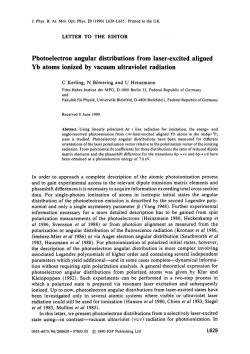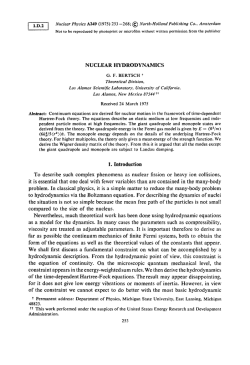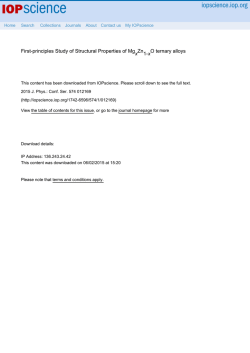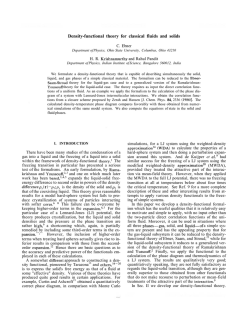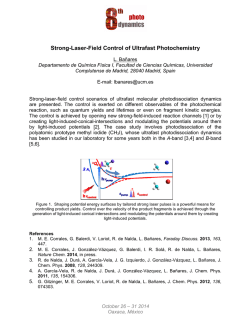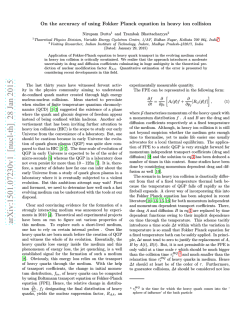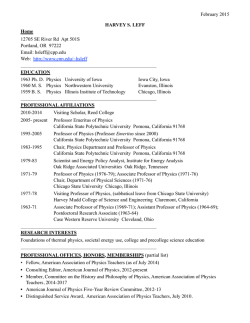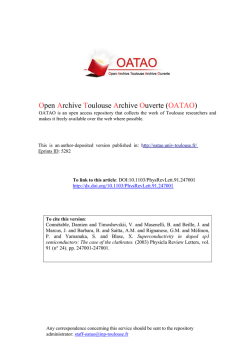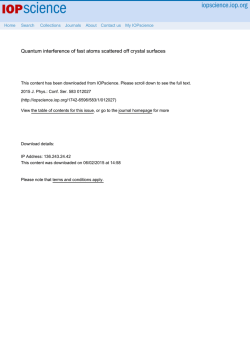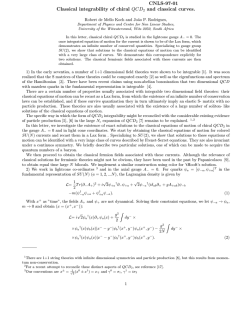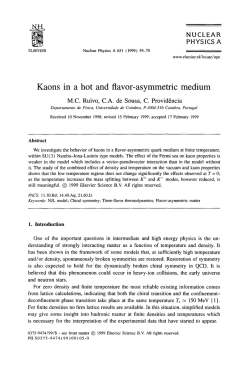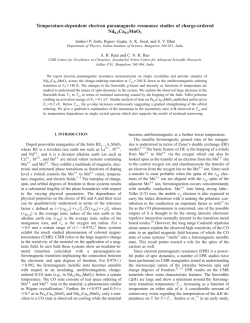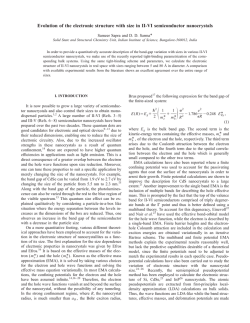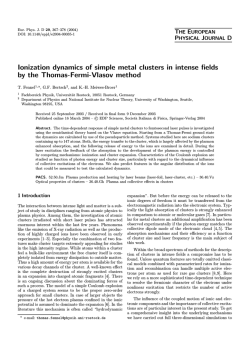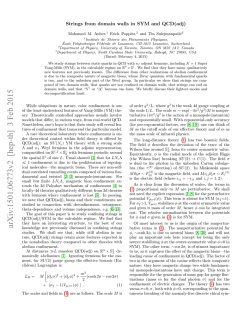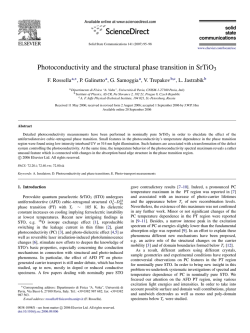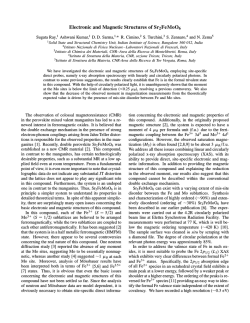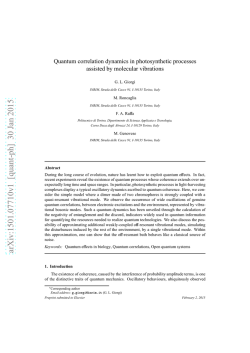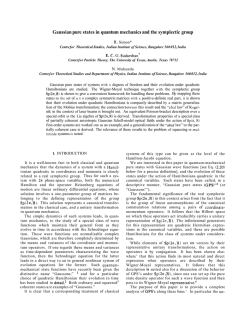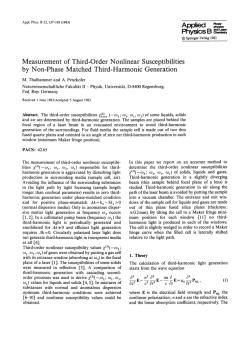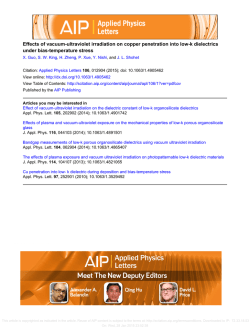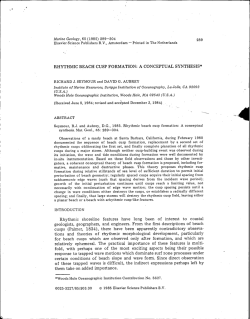
PDF (792 KB)
Home Search Collections Journals About Contact us My IOPscience When vortices and cusps meet This content has been downloaded from IOPscience. Please scroll down to see the full text. 2015 J. Phys.: Conf. Ser. 583 012026 (http://iopscience.iop.org/1742-6596/583/1/012026) View the table of contents for this issue, or go to the journal homepage for more Download details: IP Address: 136.243.24.42 This content was downloaded on 06/02/2015 at 14:09 Please note that terms and conditions apply. 17th International Conference on the Physics of Highly Charged Ions Journal of Physics: Conference Series 583 (2015) 012026 IOP Publishing doi:10.1088/1742-6596/583/1/012026 When vortices and cusps meet ´ K¨ F Navarrete1,2 , M Feole1,2 , R O Barrachina1,2 and A ov´ er3 1 Centro At´ omico Bariloche ((Comisi´ on Nacional de Energ´ıa At´ omica), R8402AGP S. C. de Bariloche, R´ıo Negro, Argentina 2 Instituto Balseiro (Comisi´ on Nacional de Energ´ıa At´ omica y Universidad Nacional de Cuyo), R8402AGP S. C. de Bariloche, R´ıo Negro, Argentina 2 3 Institute for Nuclear Research, Hungarian Academy of Sciences (Atomki), P.O. Box 51, H-4001 Debrecen, Hungary E-mail: [email protected] Abstract. After being overlooked for decades, the presence of quantum vortices in atomic ionization processes was recently uncovered both theoretically and experimentally. On the other hand, the electron capture to the continuum cusp is one of the most conspicuous and well-studied features of the multiple differential cross section in the ionization of atoms by the impact of positively charged projectiles. Here we analyze the conditions for these two structures to approach each other in the configuration space of the transition matrix element, and the effects that this encounter might produce. 1. Introduction The well-known electron-capture-to-the-continuum (ECC) cusp was first observed more than four decades ago in ion-atom ionization collisions [1], and more recently in positron impact collisions [2]. On the other hand, and in spite of some early evidences [3, 4, 5, 6, 7], quantum vortices in atomic and molecular processes were uncovered only some few years ago. Until now, they were experimentally observed in the ionization of atoms by the impact of electrons [10] and ions [11], and theoretically analyzed for positrons [12] and electric pulses [13]. Vortices and cusps are different in origin and structure. Vortices formed in the wave function during the early stages of the collision [8] might collapse at later times, but some can eventually survive up to the asymptotic regime and manifest themselves as zeros of the ionization matrix element T . The simultaneous conditions Re(T ) = 0 and Im(T ) = 0 define a manifold V with co-dimension 2 in the multidimensional configuration space of T . The generalized velocity field u = Im [(∇k T )/T ], with k a two-dimensional momentum orthogonal to V, rotates around it with a 2π quantization that assures the single valuation of T . On the other hand, the ECC cusps can be explained in terms of a smooth continuation across the ionization limit of capture into highly excited bound states of the projectile [14]. It appears as a 1/k ′ divergence in |T |2 occurring at the threshold of the charge exchange process, where k ′ is the electron-projectile relative momentum. The condition k′ = 0 defines a manifold C with dimension 3 in the configuration space of T . While the ECC cusp is a quite ubiquitous feature of ion-atom and positron-atom ionization collisions, and has been extensively observed and studied, the experimental observation of vortices, i.e. deep and confined minima of the electron momentum distribution, is not exempt Content from this work may be used under the terms of the Creative Commons Attribution 3.0 licence. Any further distribution of this work must maintain attribution to the author(s) and the title of the work, journal citation and DOI. Published under licence by IOP Publishing Ltd 1 17th International Conference on the Physics of Highly Charged Ions Journal of Physics: Conference Series 583 (2015) 012026 IOP Publishing doi:10.1088/1742-6596/583/1/012026 of difficulties. In particular, they have only been observed in (e,2e) experiments and in 10 keV/amu He2+ +He transfer ionization collisions, and in this latter case only at the saddle point region and for large projectile scattering angles [11]. No experimental observation of vortices in positron-atom collisions has been reported so far. In this article we propose an indirect method for observing a vortex, consisting in the analysis of the strong distortion that it might produce on the ECC cusp for particular experimental conditions. Calculations performed with the Lattice-Time-Dependent Schr¨odinger Equation method (LTDSE) for the ionization of atomic Hydrogen by 5 keV protons at unit impact parameter have already showed the presence of vortices near the ECC cusp [8]. Similarly, in a previous article we uncovered the presence of a vortex near the ECC cusp for positron impact at 100 and 200 eV. Figure 1. In the energy sharing or collinear geometry employed in this article, the angles formed by the electron θ− and the projectile θ+ with respect to the forward direction are equal, θ− = θ+ , while their relative azimuthal angle is zero, φ = 0. qq+ j 2. Transition Matrix Element We evaluate the transition matrix element T for the ionization of Hydrogen by the impact of energetic charged projectiles by means of a correlated approximation of the final three-body state. Details of the theoretical approach were described in previous articles [12, 16, 15]. Here, instead of fixing the projectile’s emission angle or using the “symmetric geometry” [17] that is standard in studies of (e,2e) collisions, we employ an “energy sharing” or collinear arrangement, where the electron and the projectile move along the same direction in the final state, as it is shown in figure 1. Figure 2. Square modulus of the transition matrix element, |T |2 , in a collinear geometry, for the ionization of hydrogen atoms by the impact of a 50 eV positrons, as a function of the electron energy for different emission angles θ− = 0◦ (blue line), 25.5◦ (black line) and 45◦ (red line). The curves have been renormalized so as to coincide on the right side of the ECC cusp. 1 0 deg |T| 2 (arbitrary units) 2 45 deg 25.5 deg 0 16 17 18 19 20 Electron Energy (eV) 2 17th International Conference on the Physics of Highly Charged Ions Journal of Physics: Conference Series 583 (2015) 012026 IOP Publishing doi:10.1088/1742-6596/583/1/012026 In figure 2 we display the square modulus of the matrix element, |T |2 for a 50 eV e+ + H ionization collision, as a function of the electron energy for different emission angles θ. For θ = 0◦ the ECC cusp shows the well-known asymmetry towards lower energies, an effect common to ion and positron impact that has been extensively studied in the literature. But we now observe that a sudden modification of the the cusp’s shape occurs at θ = 25.5◦ , where the lower energy side of the ECC cusp is strongly suppressed. Up to our best knowledge this effect has neither been observed nor predicted before. Finally, the standard shape of the ECC is recovered for θ = 45◦ . We claim that this effect is due to the presence of an isolated zero in the transition matrix element, as shown in figure 3. In fact, this zero corresponds to a vortex [12] at its very emergence, which remarkably occurs near the ECC cusp. It can be further demonstrated that its angular position is fairly insensitive to the impact energy. Thus, it produces the strong distortion of the lower-energy side of the ECC cusp. Figure 3. Square modulus of the transition matrix element for the ionization of a Hydrogen atom by the impact of a positron of 50 eV. Conditions are set to a collinear geometry configuration (as explained in Fig 1). The logarithmic scale in arbitrary units sets the lowest and highest values in dark red and light yellow, respectively. This kind of indirect evidence of a vortex might show up in different characteristics of the Multiple Differential Cross Section (MDCS) in prospective experiments. For instance, it might be observable as a sudden drop of the full width at half maximum (FWHM) or as a shift towards higher energies of the ECC cusp position at intermediate emission angles. However these rather subtle effects might be difficult to resolve experimentally. Bearing this last limitation in mind, we calculated the left-side yield of the ECC cusp. As it is shown in figure 4 this quantity, that should be more feasible to be measured, displays a sharp minimum at precisely the angular position of the vortex. 3. Conclusions Vortices are very well-known features of many-body systems. They are routinely observed in gases, liquids and plasmas, and in connection with quantum effects as superconductivity, superfluity, and Bose - Einstein condensation. The description of these many body systems customarily resorts to the inclusion of ad-hoc potentials or nonlinear terms. Here, on the other hand, we have investigated their appearance in an extremely simple three-body quantum system in the continuum. 3 17th International Conference on the Physics of Highly Charged Ions Journal of Physics: Conference Series 583 (2015) 012026 IOP Publishing doi:10.1088/1742-6596/583/1/012026 Yield (arbitrary units) 2 1 0 20 30 40 50 Figure 4. Yield of the square modulus of T in an energy range between 15.7 and 18.2 eV (the latter being the energy corresponding to the ECC cusp) as a function of the emission angle. 60 Emission Angle (degrees) However, since the only fingerprint of a vortex in the MDCS is a deep and confined minimum, its experimental observation is hindered by difficulties of resolution and low intensity. Fortunately, as we showed in this article, the emergence of one of them in the proximity of such a conspicuous feature of the MDCS, as the ECC cusp, could help in its experimental determination. We also presented the calculation of the yield, which we hope that could make its experimental observation easier. Acknowledgments This work was supported by the Hungarian - Argentinean MINCYT-NIO Cooperation Programme in Science and Technology (grant no HU/10/07), by Comisi´on Nacional de Energ´ıa At´omica, CNEA and Universidad Nacional de Cuyo (Grant 06/C416) and by the Hungarian Scientific Research Foundation (OTKA K104409). FN and ROB are also members of the Consejo Nacional de Investigaciones Cient´ıficas y T´ecnicas (CONICET), Argentina. References [1] [2] [3] [4] [5] [6] [7] [8] [9] [10] [11] [12] [13] [14] [15] [16] [17] Crooks G B and Rudd 1970 Phys. Rev. Lett. 25 5309 K¨ ov´er A and Laricchia G 1998 Phys. Rev. Lett. 80 5309 Brauner M and Briggs J S 1991 J. Phys. B: At. Mol. Opt. Phys. 24 2227 Botero J and Macek J H 1992 Phys. Rev. A 45 15 Murray A J and Read F H 1993 J. Phys. B: At. Mol. Opt. Phys. 26 L359 Berakdar J and Briggs J S 1994 Phys. Rev. Lett. 72 3799 Berakdar J and Briggs J S 1994 J. Phys. B: At. Mol. Opt. Phys. 27 4271 Macek J H, Sternberg J B, Ovchinnikov S Y, Lee T-G, and Schltz D R 2009 Phys. Rev. Lett. 102 143201 Ovchinnikov S Y, Macek J H, Schmidt L PH H and Schultz D R 2011 Phys. Rev. A 83 060701 Macek J H, Sternberg J B, Ovchinnikov S Yu and Briggs J S 2010 Phys. Rev. Lett. 104 033201 Schmidt L Ph H, Goihl C, Metz D,Schmidt-B¨ ocking H, D¨ orner R, Ovchinnikov S Yu, Macek J H and Schultz D R 2014 Phys. Rev. Lett. 112 083201 Navarrete F, Della Picca R, Fiol J and Barrachina R O 2013 J. Phys. B: At. Mol. Opt. Phys. 46 115203 Ovchinnikov S Yu, Sternberg J B, Macek J H, Lee T-G and Schultz D R 2010 Phys. Rev. Lett. 105 203005 Macek J 1970 Phys. Rev. A 1 235 Fiol J, Rodr´ıguez V D and Barrachina R O 2001 J. Phys. B: At. Mol. Opt. Phys. 34 933 Della Picca R, Fiol J and Barrachina R O 2005 Nucl. Instrum. Methods B 247 52 Gottschalk B, Shlaer W J and Wang K H 1965 Phys. Lett. 16 294 4
© Copyright 2024
